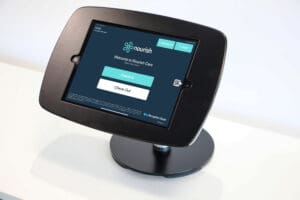So, you’ve decided to take your care planning to the next level and implement digital care planning across your care service – what happens next and how do you start the process of digitalising your care records?
1. Researching platforms & what is important to your care service
The first step in your digital transformation journey is to start researching the digital care records platforms available to you. The best place to start is by looking at the NHS Transformation Directorate’s Digital Social Care Records Assured Supplier List.
There is currently an Adult Social Care Transformation Fund that typically covers 50% of your first-year costs for an Assured Supplier digital care records platform. This will often additionally include financial support for your teams to receive training as well as devices.
It’s key to also look out for what cyber security accreditations platforms have such as ISO20071 and Cyber Essentials Plus. These accreditations will give you an idea of which platforms have an extra layer of security to give you peace of mind.
Prioritise selecting a user-friendly platform that meets your care service’s specific needs. Look for a system that is easy to navigate, customisable, and provides real-time data to help your staff make informed decisions. The Nourish platform is designed with the user in mind and is simple, clear and easy to navigate. Key features within the app ensure that recording of information on the go is as straightforward and accurate as possible.
Define the features that are important and essential to your care service and find which platform providers are able to offer you this. Take a look at our Digital Care Planning Platform Checklist which includes key things your service needs to consider when looking for a platform to suit your needs.
2. Attending demonstrations
Once you’ve pulled together a list of digital care planning providers that you think could be suitable for your services, the next step is to attend demonstrations of their platform. Before you head into the demonstrations, ensure you have all the questions you want to ask about the features that are important to you. You should also ensure that you have the correct team available to see the platform and provide a different opinion. A demonstration from Nourish will show a day in the life of a Nourish user and this will give you a real feel of the platform, what it can do, how easy it is to use, how your care teams will use it and ultimately if it will work for your service. You can book a demo of the Nourish platform here.
3. Making a decision
Which platform really caught your eye in the demonstration? When it comes to making a decision on which platform to use, will you require a tender or a presentation in addition to the demonstration to address topics not brought up in the demo? You may think of more questions after your demonstration that are vital to your organisation’s process for choosing a platform.
Ensure you have a criteria of what you require from a platform and make your decision based on which platform fits your criteria. Whichever platform you decide to implement, ensure it is able to meet your requirements before moving ahead. Once a decision has been made, the rollout process will begin.
4. Setting up logistics
Once you’ve decided on which platform you will be using for your digital care planning, the next step is organising devices. Do you want to use the devices recommended by the provider or do you want to source your own? If you go down the route of purchasing your own devices, ensure that the device is compatible with the platform. Using the platform provider’s devices comes with its own benefits of data security and device management from the platform.
Many care services are just starting out in their digital journey and need to install WiFi before implementing a digital care planning platform. If your care services are situated in an area where the connectivity drops out, ensure the platform you choose will still work even with the WiFi down – logging care notes at the time the care is delivered and uploading them once the WiFi reconnects. Nourish users benefit from Offline Access, ensuring care is logged and evidenced at the correct time, regardless of internet stability.
5. Training
Once you’ve got the platform and devices organised, your next step is training for you and your care teams at the appropriate level. Find out if your chosen digital care planning platform has a training package to suit your needs. With Nourish, you can either go for the full training package, onsite or remote, with a dedicated trainer or for a Train the Trainer package where you train a specific set of staff and then they train the rest of your care teams. Nourish also offers a quick onboarding training tool that deploys a training carousel to all users the first time they log onto the Nourish app.
Ensure the platform you have chosen offers training to suit your needs and that the most tech savvy and passionate colleagues are involved in the training sessions to support your onboarding journey. Using your most tech savvy team members will ensure they have the skills to support other staff members who may have technical queries. You may decide to officially appoint a champion to support this as encouraging a change in practice and culture is not always smooth sailing so having members of the team champion this change will benefit your onboarding in the long run. Ensure your staff know how to contact support should they need any assistance.
6. Building care plans
Starting out with your digital care records platform will begin with the care plans of the people you support. With a platform like Nourish, you are able to choose a Library that fits your care type that comes with interactions, assessments, care plan templates and more for managing specific pathways, conditions, frailties, needs and day-to-day operational requirements for the care types you support. You can also configure and customise Nourish in a way that replicates the forms and assessments crucial to your care services’ operational needs and that looks familiar to your care teams.
By using the care plan templates, you can start building the care plans of the people you support immediately.
7. Implementation
With care plans ready and your staff trained to be experts in your chosen digital records platform, the next step is to hit the ground running and start using the platform to its full potential.
Once the system is implemented, monitor and evaluate its performance regularly. Assess the quality of the data being inputted, the accuracy of the records, and staff satisfaction with the platform. Use this feedback to make improvements and ensure that the platform is meeting your care service’s specific needs.
Transitioning to a digital social care records system can be a challenging process, particularly if you have a small care service. However, with careful planning, training, and ongoing support, using a digital social care records system often has an improvement in the quality of care provided to the people you support, and an increase in the efficiency and effectiveness of your care delivery.
Though implementation is the final step, there is more to come with digital care planning. As technology advances and best practice ideals improve, Nourish is constantly updated and improved and new partners are added to our suite of integration partners.






